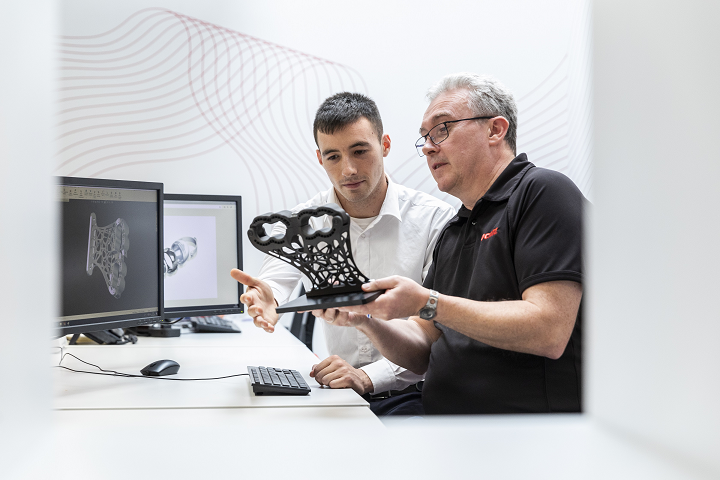German chemical company Henkel has been doubling down on its commitment to 3D printing over the last year, acquiring Molecule Corp. in California, announcing a partnership with 3D printing startup Origin, the result of which was a new resin designed to meet aerospace fire safety standards, and strengthening its existing relationship with Shapeways. Now, the 143-year-old company has proclaimed that it will leverage its in-house capabilities in order to expand its Additive Manufacturing Services.
First and foremost, these services were designed to support customers from the automotive and industrial sectors, offering help with design and 3D printing materials, all the way through until the final part has been completed.
“Within Henkel Additive Manufacturing Services, we’re focused on providing additional support to our existing industrial customers, including OEM automotive manufacturers and their top suppliers. They have very unique requirements, and we’re leveraging our vast material portfolio to help them build quality, repeatability and scalability into their additive manufacturing efforts. They want to produce end production parts, and our mission is to help them achieve that goal,” said Simon Mawson, Senior Vice President and Head of 3D Printing at Henkel.
The company’s Additive Manufacturing Services are often used in applications where fabricated parts are meant for continued serial production. Customers can utilize these services to find, and optimize, the best material for these parts, as well as get help with quality control initiatives, such as part validation and dimensional analysis. In addition, the Henkel Additive Manufacturing Services team can offer help in the earlier stages of the product development lifecycle as well, by assisting with design optimization to help achieve the desired surface finish, function, and tolerance requirements.
Henkel’s Additive Manufacturing Services use the company’s large infrastructure, along with the internal capabilities it possesses, at its certified plant in Missouri, which provides millions of parts made with conventional means of manufacturing to its industrial and automotive customers. But, these capabilities are also being leveraged at several of the company’s application centers, placed at strategic locations, which meet important industry standards, like EMS ISO 14001:2015, ISO 9001:2015, ISO/TS 16949:2006, and OHSA 18001:2007.
In addition to the materials it develops through its Loctite brand and division, and its dedicated post-processing and finishing techniques, Henkel also offers a good variety of 3D printing technologies through its Additive Manufacturing Services, such as digital light processing (DLP), MultiJet Fusion (MJF), and stereolithography (SL, or SLA).
“Knowledge of materials, and additive manufacturing workflows are critically important to the future success of 3D printing in a production environment. Equally important, and often overlooked is a knowledge of industrial customer requirement, APQP, exacting customer quality requirements, and seamless part ordering and delivery. Failure to control and manage all these factors can lead to a breakdown in customer supply chain,” explained Chris Liddiard, Henkel’s Market Segment Head Automotive and Industrial Parts. “Henkel’s long history in producing and delivering traditionally manufactured parts as a Tier 1 to multiple industries, coupled with exciting material development in additive manufacturing is a powerful combination to lead the development of the production of reliable end use parts.”

Henkel engineers are working with customers in the automotive and industrial sectors to optimize 3D printed parts. (Image courtesy of Henkel)
(Source: Chemical Engineering)
Subscribe to Our Email Newsletter
Stay up-to-date on all the latest news from the 3D printing industry and receive information and offers from third party vendors.
You May Also Like
Gorilla Sports GE’s First 3D Printed Titanium Cast
How do you help a gorilla with a broken arm? Sounds like the start of a bad joke a zookeeper might tell, but it’s an actual dilemma recently faced by...
Nylon 3D Printed Parts Made More Functional with Coatings & Colors
Parts 3D printed from polyamide (PA, Nylon) 12 using powder bed fusion (PBF) are a mainstay in the additive manufacturing (AM) industry. While post-finishing processes have improved the porosity of...
$25M to Back Sintavia’s Largest Expansion of Metal 3D Printing Capacity Since 2019
Sintavia, the digital manufacturing company specializing in mission-critical parts for strategic sectors, announced a $25 million investment to increase its production capacity, the largest expansion to its operations since 2019....
Velo3D Initiates Public Offering in a Bid to Strengthen Financial Foundations and Drive Future Growth
Velo3D (NYSE: VLD) has been among a number of publicly traded 3D printing firms that have attempted to weather the current macroeconomic climate. After posting a challenging financial report for 2023,...
































